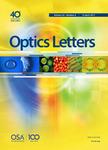版权所有:内蒙古大学图书馆 技术提供:维普资讯• 智图
内蒙古自治区呼和浩特市赛罕区大学西街235号 邮编: 010021

作者机构:Univ Basque Country Fac Sci & Technol Dept Condensed Matter Phys Bilbao 48080 Spain Univ Basque Country Fac Sci & Technol Dept Appl Phys 2 Bilbao 48080 Spain Univ Basque Country Fac Engn ETSI Dept Appl Phys 1 Bilbao 48013 Spain
出 版 物:《OPTICS LETTERS》 (光学快报)
年 卷 期:2015年第40卷第7期
页 面:1262-1265页
核心收录:
学科分类:070207[理学-光学] 07[理学] 08[工学] 0803[工学-光学工程] 0702[理学-物理学]
基 金:MINECO [MAT2012-38538-CO3-02] Basque Government [GI/IT-449-10] UPV/EHU
主 题:Lasers distributed-feedback Liquid crystals Liquid-crystal devices Scattering Rayleigh
摘 要:We have studied the degradation process of the laser emission in a cholesteric liquid crystal laser. We have found that there exists a negative correlation between the laser efficiency and the amount of light scattered by the liquid-crystal sample in the illuminated area. The growth of scattering is attributed to the appearance of small imperfections generated in the sample as a result of certain thermal processes that involve the dye molecules. The scattering implies an increase of the coefficient of distributed losses, which is the main response of the rise of the laser threshold. (C) 2015 Optical Society of America